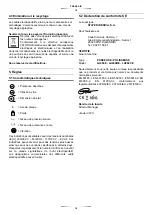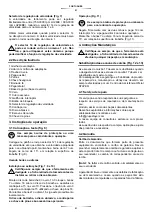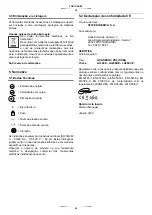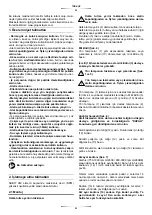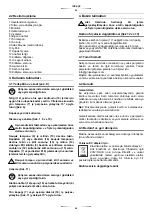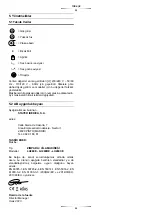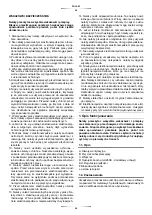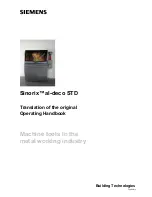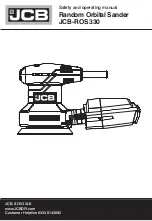
ENGLISH
11
11
This manual is consistent with the date of manufacture of
your machine, you will find information on the technical
data of the machine acquired manual check for updates
of our machines on the website:
www.grupostayer.com
1. Specific safety instructions
-
Always use eye and ear protection.
Other personal
protective equipment such as dust mask, gloves, helmet
and apron should be worn when necessary. If in doubt,
wear the protective equipment.
-
Always be sure that the tool is switched off and
unplugged before carrying out any work on the tool.
-
Accessories must be rated for at least the speed
recommended on the tool warning label.
Wheels and
other accessories running over rated speed can fly apart
and cause injury.
-
Check the backing pad carefully for cracks, damage
or deformity before operation.
Replace cracked,
damaged or deformed pad immediately.
-
Check that the workpiece is properly supported.
- Hold the tool firmly.
- Keep hands away from rotating parts.
- Make sure abrasive disc or wool bonnet is not
contacting the workpiece before the switch is turned
on.
- When sanding metal surfaces, watch out for flying
sparks.
Hold the tool so that sparks fly away from you and
other persons or flammable materials.
-
Do not leave the tool running.
Operate the tool only
when hand-held.
-
Pay attention that the wheel continues to rotate after
the tool is switched off.
- Do not touch the workpiece immediately after
operation; it may be extremely hot and could burn
your skin.
- If working place is extremely hot and humid, or
badly polluted by conductive dust, use a short-circuit
breaker (30 mA) to assure operator safety.
- Do not use the tool on any materials containing
asbestos.
- Do not use water or grinding lubricant.
- Ventilate your work area adequately when you
perform sanding operations.
- Always use the correct dust mask/respirator for the
material and application you are working with.
- Ensure that ventilation openings are kept clear
when working in dusty conditions.
If it should become
necessary to clear dust, first disconnect the tool from
the main supply (use non metallic objects) and avoid
damaging internal parts.
Save these instructions
2. Commissioning Instructions
Thanks to the CONSTANT SPEED system, your machine
will keep the revolutions per minute (RPM) constant
between noload conditions and load.
2.1 Mounting
Installing loop handle
Always be sure that the tool is switched off and
unplugged before installing the loop handle.
Always install the loop handle 4 on the tool before
operation.
Install the loop handle 4 so that will fit into the
matching hole in the handle housing 2. (Fig.1)
Install the bolts 5 and tighten them with the hex
wrench 6.
The loop handle 4 can be installed in two different
directions as shown in Fig. 2 & 3, whichever is convenient
for your work.
Shaft lock (Fig. 4)
Press the shaft lock 3 to prevent spindle
10
rotation when
installing or removing accessories such as wool pads
7
.
Never actuate the shaft lock 3 when the spindle
10 is moving. The tool may be damaged.
Installing or removing wool pad (Fig. 1 & 5)
Always be sure that the tool is switched off and
unplugged before installing or removing the
wool pad.
To install the wool pad 7, first remove all dirt or foreign
matter from the backing pad 9. Press the shaft lock 3 and
screw the backing pad 9 onto the spindle 10.
To remove the wool pad 7, just tear it off the backing pad
9
. Then unscrew the backing pad 9 while pressing the
shaft lock
3.
Switch action (Fig. 6)
Before plugging in the tool, always check to see that
the switch trigger actuates properly and returns to the
‘‘OFF’’ position when released.
To start the tool, simply pull the trigger 12. Release the
trigger 12 to stop.
For continuous operation, pull the trigger 12 and then
push in the lock button 13.
To stop the tool from the locked position, pull the trigger 12
fully, then release it.
Speed adjusting dial (Fig. 7)
The tool speed can be infinitely adjusted between (750-
3300 rpm LU260E / 900-3000 rpm LU260BE) by turning
the speed adjusting dial 14 to a given number setting from
1 to 6.
Higher speed is obtained when the dial 14 is turned in the
direction of number 6; lower speed is obtained when it is
turned in the direction of number 1.
Summary of Contents for LU260BE
Page 2: ...Fig 1 Fig 3 Fig 5 Fig 7 Fig 2 Fig 4 Fig 6 Fig 8 4 1 19 7 9 13...
Page 3: ...11 Fig 9 Fig 11 Fig 13 Fig 10 Fig 12 17 15 16 1 7 9 16 Fig 14 8...
Page 29: ...NOTAS 29...
Page 30: ...NOTAS 30...
Page 31: ...NOTAS 31...



















